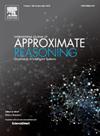随机矩阵的直径:贝叶斯网络灵敏度分析的一种新测度
IF 3
3区 计算机科学
Q2 COMPUTER SCIENCE, ARTIFICIAL INTELLIGENCE
引用次数: 0
摘要
贝叶斯网络是风险管理和决策支持中使用最广泛的概率模型之一,因为它们在包括异构信息片段方面具有可解释性和灵活性。在任何应用的建模中,评估对某些目标变量的推断对模型变化的鲁棒性是至关重要的。在贝叶斯网络中,这些分析属于敏感性分析的范畴,最常用的是通过使用Kullback-Leibler信息度量来量化差异。我们认为基于总变异距离的鲁棒性方法为错误规范的鲁棒性提供了简单和更有价值的界限,这在形式上是合理的和透明的。我们在条件概率表中引入了一种新的称为直径的依赖性度量来推导这样的边界。这种方法量化了变量与其父变量之间的依赖程度。此外,直径是一个通用的测量,可以应用于广泛的灵敏度分析任务。它对于量化边缘强度、评估变量对之间的影响、检测不对称依赖和合并变量水平特别有用。这种灵活性使直径成为在应用风险管理和决策支持中增强贝叶斯网络模型的鲁棒性和可解释性的宝贵工具。本文章由计算机程序翻译,如有差异,请以英文原文为准。
The diameter of a stochastic matrix: A new measure for sensitivity analysis in Bayesian networks
Bayesian networks are one of the most widely used classes of probabilistic models for risk management and decision support because of their interpretability and flexibility in including heterogeneous pieces of information. In any applied modelling, it is critical to assess how robust the inferences on certain target variables are to changes in the model. In Bayesian networks, these analyses fall under the umbrella of sensitivity analysis, which is most commonly carried out by quantifying dissimilarities using Kullback-Leibler information measures. We argue that robustness methods based instead on the total variation distance provide simple and more valuable bounds on robustness to misspecification, which are both formally justifiable and transparent. We introduce a novel measure of dependence in conditional probability tables called the diameter to derive such bounds. This measure quantifies the strength of dependence between a variable and its parents. Furthermore, the diameter is a versatile measure that can be applied to a wide range of sensitivity analysis tasks. It is particularly useful for quantifying edge strength, assessing influence between pairs of variables, detecting asymmetric dependence, and amalgamating levels of variables. This flexibility makes the diameter an invaluable tool for enhancing the robustness and interpretability of Bayesian network models in applied risk management and decision support.
求助全文
通过发布文献求助,成功后即可免费获取论文全文。
去求助
来源期刊

International Journal of Approximate Reasoning
工程技术-计算机:人工智能
CiteScore
6.90
自引率
12.80%
发文量
170
审稿时长
67 days
期刊介绍:
The International Journal of Approximate Reasoning is intended to serve as a forum for the treatment of imprecision and uncertainty in Artificial and Computational Intelligence, covering both the foundations of uncertainty theories, and the design of intelligent systems for scientific and engineering applications. It publishes high-quality research papers describing theoretical developments or innovative applications, as well as review articles on topics of general interest.
Relevant topics include, but are not limited to, probabilistic reasoning and Bayesian networks, imprecise probabilities, random sets, belief functions (Dempster-Shafer theory), possibility theory, fuzzy sets, rough sets, decision theory, non-additive measures and integrals, qualitative reasoning about uncertainty, comparative probability orderings, game-theoretic probability, default reasoning, nonstandard logics, argumentation systems, inconsistency tolerant reasoning, elicitation techniques, philosophical foundations and psychological models of uncertain reasoning.
Domains of application for uncertain reasoning systems include risk analysis and assessment, information retrieval and database design, information fusion, machine learning, data and web mining, computer vision, image and signal processing, intelligent data analysis, statistics, multi-agent systems, etc.
 求助内容:
求助内容: 应助结果提醒方式:
应助结果提醒方式:


